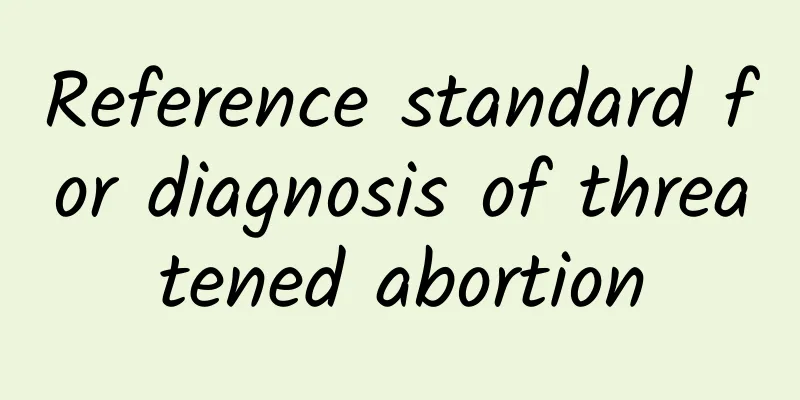Reference standard for diagnosis of threatened abortion

|
What are the diagnostic reference standards for threatened abortion? Pregnant mothers should be happy, but if threatened abortion occurs, it is a bad thing. Let's first supplement some knowledge and learn with the editor what the diagnostic reference standards for threatened abortion are. Threatened abortion refers to a small amount of vaginal bleeding before 28 weeks of pregnancy, followed by paroxysmal lower abdominal pain or back pain. Pelvic examination shows that the cervix is not dilated, the fetal membranes are intact, no pregnancy products are discharged, and the size of the uterus is consistent with the gestational age. If the symptoms worsen, it may develop into inevitable abortion. Abortion goes through a series of processes from the beginning to the end. According to its different stages, it can be given different diagnostic names, namely: threatened abortion, inevitable abortion, incomplete abortion, complete abortion, and delayed abortion. During pregnancy, backache, abdominal pain, and prolapse, accompanied by a small amount of vaginal bleeding and a slippery pulse, are diagnosed as fetal movement disorder. 1. Western medicine diagnostic criteria: (1) Medical history: history of amenorrhea and early pregnancy reactions. (2) Symptoms: Vaginal bleeding, accompanied by lower abdominal pain or back pain. (3) Gynecological examination: The cervix is not dilated and the enlargement of the uterus is consistent with the gestational age. (4) Auxiliary examinations: positive urine pregnancy test or elevated blood HCG value, or B-ultrasound indicating intrauterine pregnancy. (5) Health guidance 2. TCM diagnostic criteria: (1) Fetal leakage: A small amount of vaginal bleeding during pregnancy that comes and goes, or continues without backache, abdominal pain, or lower abdominal distention is called "fetal leakage", also known as "uterine leakage" or "fetal leakage". Fetal leakage often occurs in the early stages of pregnancy. (2) Fetal movement disorder: If a woman experiences lower back pain, abdominal pain, fetal movement or a small amount of vaginal bleeding during pregnancy, it is called "fetal movement disorder", also known as "fetal gas disorder". |
<<: What are the four treatments for threatened abortion?
>>: Common treatments for threatened miscarriage
Recommend
What are the prevention methods of adnexitis?
Adnexitis is a common disease. Nowadays, there ar...
Uncles also have big muscles! Daily exercises to strengthen your muscles
I get out of breath after climbing just a few ste...
Can I massage my soles during menstruation? Is it harmful to massage my soles during menstruation?
The most annoying thing for women every month is ...
Will ectopic pregnancy cause back pain?
Ectopic pregnancy is clinically called ectopic pr...
How to treat irregular menstruation at 45 years old? 9 foods to eat for irregular menstruation at 45 years old
Menstruation is a normal physiological cycle for ...
Causes of recurrent miscarriage
Recurrent miscarriage is very harmful and is an i...
Can endometrial tuberculosis be completely cured?
Endometrial tuberculosis is a very serious gyneco...
Don’t be afraid of starch when losing weight! Eat more of these 6 foods
"Starch is innocent!" Many people menti...
What are the main symptoms of cervical hypertrophy?
The appearance of cervical hypertrophy has brough...
Eating dinner too late can lead to obesity and diabetes
The order of a meal, such as what to eat and eati...
What preparations should be made before abortion surgery?
Abortion is a common medical procedure. In order ...
Do I need to drink soup to replenish my nutrition after an abortion? What is the remedy for catching a cold after an abortion?
Abortion is currently considered a relatively min...
What medicine should I take if I don't have my period?
What medicine should I take if I don’t have my pe...
What is endometrial tuberculosis?
What is the cause of endometrial tuberculosis? Wh...
Those who want to lose weight must know! 5 types of weight loss to follow
Different types of obesity caused by different ca...









